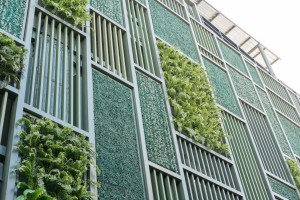Is Biophilic Design What's Missing in Your Office Project?

Green facade, vertical garden in architecture
Want to increase happiness and productivity for your clients in your next office project? Learn how biophilic design can improve your spaces!
In today’s fast-paced, highly productive (and in many cases, highly stressed!) work environments, many of us like to personalize our working spaces with a natural element or two, such as a leafy green potted plant, or maybe even a miniature bubbling desktop water fountain that produces relaxing sounds that remind us of being outdoors, surrounded by nature.
But do these seemingly little things have an effect on our outlook and well-being?
If you ask retail space designers and merchandisers, the answer is a definite yes. For many years, savvy retailers have incorporated numerous “tricks of the trade” to subtly influence our mood when shopping. Today’s retail environments have progressed far beyond yesterday’s ubiquitous Muzak. They now incorporate realistic natural elements, ranging from signature aromas (shopping aromatherapy anyone?) to enhanced HVAC technology that randomly alters the temperature slightly, accompanied by naturalistic “gusts” of fresh air — all designed to encourage us to be happy and, most importantly, to shop.
Of course, there’s a long history of nature inspiring design. In fact, you might ask yourself, what could be new about design being inspired by nature or vice versa? For example, if we look back thousands of years to the classical order of Greek columns, it is thought the fluted columns took their original inspiration from wheat harvests bound together in sheafs. (This figurative representation of real-world physical objects is known as skeuomorphism, an approach that has given us both virtual buttons and sliders on the UI of an iPhone as well as ersatz, vinyl wood-grain sided station wagons in the 1970s.) Product designers and engineers often look to nature for inspiration, for example, the study of gecko toes and chameleon tongues has influenced the development of non-stick adhesives — a design approach known as bio-mimicry.
But what we’re talking about today is neither skeuomorphism nor bio-mimicry, but a concept known as biophilia, first written about by the German philosopher Erich Fromm in the middle of the twentieth century. Fromm postulated that humans have an innate interdependence with nature — a concept he termed biophilia — that’s intertwined by eight basic human needs:
-Relatedness
-Transcendence
-Rootedness
-Sense of Identity
-Frame of orientation
-Excitation and Stimulation
-Unity
-Effectiveness
In his 1984 book Biophilia, American biologist and author Edward O. Wilson, popularized the theory of biophilia as the “love of life or living systems” and promoted the idea that we as humans are part of nature and therefore need to have nature surrounding us in order to be happy and productive.
The Business Benefits of Biophilic Architecture Design
Since that time, the biophilia philosophy has inspired a new generation of architects, interior designers, and space planners to develop a new design movement — Biophilic architecture — that incorporates prominent natural elements directly into the visual (and sensual) language of modern interior and exterior designs.
(You may recall we wrote about the emerging Biophilia trend at this year’s NeoCon contract furniture trade show that took place in Chicago this past June 2017.)
As a design language, the biophilic design movement can be seen as a logical extension of sustainable design; in fact, successful biophilic designs can dovetail quite nicely with LEED-certified sustainable building designs.
But while the return on investment from sustainable designs is measured in terms of reducing energy costs (and our carbon footprint) or limiting the number of unnecessary building materials filling up the world’s landfills, the tangible economic benefits of biophilic design come from measurable increases in employee health and performance in the workplace.
TIP: If you want to attract millennial employees in the workplace, biophilic-inspired office designs can provide an edge in recruiting younger generation workers who are attracted to workspaces with natural environments that reflect their active, outdoor lifestyles.
Researchers continue to uncover more and more evidence of the financial benefits that biophilic design brings to our work environments.
The Human Spaces Report measured the positive impact that incorporating natural elements, such as natural lighting, careful color choices, and natural imagery can have on workers as well as patients in hospitals. In some cases, it can be quite dramatic: in a study of Genzyme Corporation, 75% of workers felt more connected to their fellow employees after moving into a new headquarters building that was flooded with natural light and kitted out with indoor gardens.
The design consultancy Terrapin has created a comprehensive guide to the available research literature the positive economic effect of implementing biophilia principles in office spaces and residential homes.
According to Terrapin, designers and architects should consider fourteen different design principles when implementing a biophilic design program, each of which can have one or more measurable health and wellness benefits:
Visual connection with nature:
Results in lower blood pressure, improved attentiveness, and overall happiness
Non-visual connection with nature:
Lowers stress hormones, increase cognitive performance, improves perceived mental health state
Non-rhythmic sensory stimuli:
Improves sympathetic nervous system activity, increases attention span
Thermal and airflow variability:
Raises comfort, well-being, and productivity levels through increased concentration
Presence of water:
Reduces stress, increases concentration and memory restoration, perceived positive emotions
Dynamic and diffuse light:
Increases visual comfort, improves circadian rhythms
Connection with natural systems:
Enhanced positive health response and perception of environment
Biomorphic forms and patterns:
Preferred by test subjects
Material connection with nature:
Increases creative performance and comfort improves blood pressure readings
Complexity in order:
Improves physiological stress responses
Prospect space:
Reduces stress, boredom, irritation, and fatigue; increases comfort and safety perception
Refuge space:
Increases concentration, attention levels, and perceived safety levels
Mystery space:
Increases pleasure response
Risk/peril space:
Increases dopamine levels and increases pleasure response
Meet the Masters of Biophilic Architecture Design
Let’s take a brief survey of some of the most iconic biophilic architecture designs from around the world.
Read more ... https://formaspace.com/articles/office-furniture/biophilic-design-office-project/?utm_source=linkedin&utm_source=einpresswire&utm_medium=social&utm_medium=content&utm_campaign=article-071217&utm_campaign=article-071218
Brooke Turner
Formaspace
8002511505
email us here
Legal Disclaimer:
EIN Presswire provides this news content "as is" without warranty of any kind. We do not accept any responsibility or liability for the accuracy, content, images, videos, licenses, completeness, legality, or reliability of the information contained in this article. If you have any complaints or copyright issues related to this article, kindly contact the author above.


